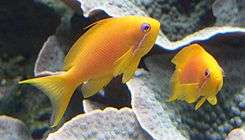Anthiinae
| Anthiinae | |
|---|---|
 | |
| Sea goldie, Pseudanthias squamipinnis | |
| Scientific classification | |
| Kingdom: | Animalia |
| Phylum: | Chordata |
| Class: | Actinopterygii |
| Order: | Perciformes |
| Family: | Serranidae |
| Subfamily: | Anthiinae |
| Genera | |
|
See text. | |
Anthias are members of the family Serranidae (basses, basslets, groupers) and make up the subfamily Anthiinae. Anthias make up a sizeable portion of the population of pink, orange, and yellow reef fishes seen swarming in most coral reef photography and film.
Anthias are mostly small, thus are quite popular within the ornamental fish trade. They form complex social structures based on the number of males and females and also their position on the reef itself, and are mainly zooplankton feeders. They occur in all tropical oceans and seas of the world. The first species recognized in this group was described in the Mediterranean and northeast Atlantic and was given name Anthias anthias by Carolus Linnaeus in 1758.
Anthias can shoal by the thousands. Anthias do school in these large groups, though they tend toward more intimate subdivisions within the school, appropriately called "harems". These consist of one dominant, colorful male, and two to 12 females — which have their own hierarchy among them — and up to two 'subdominant' males, often less brightly colored and not territorial. Within the swarm of females, territorial males perform acrobatic U-swim displays and vigorously defend an area of the reef and its associated harem.
Anthias are protogynous hermaphrodites. All anthias are born female; if a dominant male perishes, the largest female of the group will often change into a male to take its place. This may lead to squabbling between the next-largest male, which sees an opportunity to advance, and the largest female, whose hormones are surging with testosterone.
Seven genera of anthias are known to occur in coral reef ecosystems: Holanthias, Luzonichthys, Nemanthias, Plectranthias, Pseudanthias, Rabaulichthys, and Serranocirrhitus. Members of all these genera make it into the aquarium trade, although Pseudanthias is by far the most encountered in the hobby.
Species
- Genus Anatolanthias
- Genus Anthias
- Genus Caesioperca
- Butterfly perch, C. lepidoptera (Forster, 1801)
- Genus Caprodon
- Pink maomao, C. longimanus (Günther, 1859)
- Genus Dactylanthias
- Genus Giganthias
- Genus Hemanthias
- Genus Holanthias
- Genus Hypoplectrodes
- Genus Lepidoperca
- Genus Luzonichthys
- Genus Meganthias
- Genus Nemanthias
- Genus Odontanthias
- Genus Othos
- Genus Plectranthias
- Genus Pronotogrammus
- Genus Pseudanthias
- Sea goldie, P. squamipinnis
- Genus Rabaulichthys
- Genus Sacura
- Genus Selenanthias
- Genus Serranocirrhitus
- Genus Tosana
- Genus Tosanoides
- Genus Trachypoma
- Toadstool groper, T. macracanthus Günther, 1859
References
- "Anthiinae". Integrated Taxonomic Information System. Retrieved 17 March 2006.